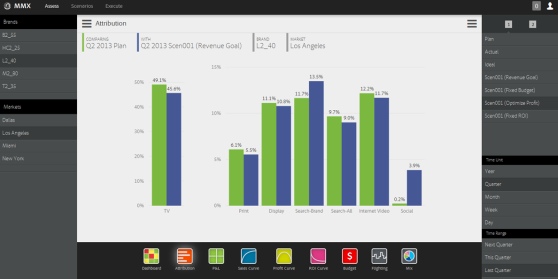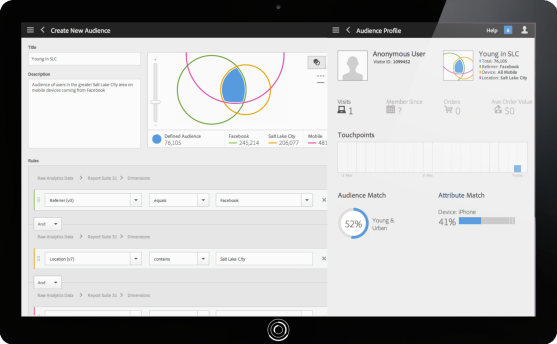Want smarter insights in your inbox? Sign up for our weekly newsletters to get only what matters to enterprise AI, data, and security leaders. Subscribe Now
Adobe just fired a big shot across the bow of enterprise marketing competitors Salesforce, IBM, and Oracle with a huge update to the Adobe Marketing Cloud that sees major changes to almost all of its components.
The biggest change?
A new common layer, called Core Services, that deeply integrates all six of the company’s marketing solutions in what Adobe says is an unprecedented way that will take the pain of IT integrations away from already-busy marketers.
“We believe this will differentiate one marketing cloud from another,” Adobe VP Suresh Vittal told me in a series of interviews over the past week. “Marketers should not have to deal with the nitty-gritty of integration while they’re integrating … it just takes away from time spent on the customer experience.”
VB recently studied marketing automation with over 1,000 marketers.
Here’s what we found.
Adobe’s marketing cloud consists of six sets of marketing features.
Adobe Marketing Cloud components
There’s Media Optimizer, which helps brands make the right ad buying decisions and integrate with demand-side ad platforms.
There’s Adobe Social, which allows clients to monitor, share, and participate in conversations, and run social media campaigns.
There’s Experience Manager, which helps companies build web experiences, manage content, and build communities, and Target, which allows them to personalize those experiences, run multivariate content tests, and automate custom product recommendations.
There’s Campaign, which is marketing automation software that came to Adobe in the Neolane acquisition.
And there’s Adobe Analytics, which helps brands understand what’s happening and why, and what to do about it.
All together, it’s a significant set of features. And it’s something that 17 of the top 20 online retailers and major brands like Audi and Lenovo and Intel and Safeway are already using to deliver 460 billion assets and complete over 18 trillion digital transactions annually, according to Adobe.
Core Services
Now, with its Core Services layer, Adobe is taking away complexity and integration challenges. Not at the software level — that’s already integrated — but at the data and marketing campaign level.
“Competitors are forcing marketers to deal with integration, spending hundreds of thousands of dollars,” Vittal told me. “Core Services includes things like our Master Marketing Profile, a one-of-a-kind in the industry which helps marketers harmonize their customers into one single actionable view.”
The key idea behind Core Services is that datasets you create or campaigns you define in any of the six major Adobe Marketing Cloud tools are available everywhere, instantly. Define a campaign once, use it anywhere.
For example, if you find in Adobe Analytics that people who visit your top five product pages are the most likely to buy, Adobe Campaign picks that up “auto-magically,” Vittal says, and allows you to create an email program, a personalized direct mail coupon, or a mobile app experience that is built just for that set of people. Adobe Target picks up that segmentation and can run A/B tests to determine just the right offers and just the right language. And a new Shared Assets functionality allows brands to sync, store, find, and use digital assets all throughout the six cloud tools.
“The audience is created once in any of the solutions,” Vittal says. “And then integrated across the cloud to create actionable views of the customer.”
Enterprise marketing clouds from competitors certainly allow their clients to integrate customer data, but don’t provide as clean and simple a set of tools that automatically sense campaigns, segmentations, and assets like Core Services promises to do.
Adobe will announce these changes at its Digital Marketing Summit in Salt Lake City today, but there are many other new features coming.
In addition to Core Services, Adobe is releasing Marketing Mix Planning, a tool that promises to give chief marketing officers direct, clear insight into exactly how each of their marketing channels is performing. This, of course, provides answers for the age-old attribution problem: which of my ads are working?
“If you only had one more marketing dollar to spend, Marketing Mix would tell you the best place to spend it,” Vittal says.
The company will preview Marketing Mix at Summit, and release it “in a few months.”
New mobile goodies … including iBeacon
In addition, Adobe announced that PhoneGap, its open-source, cross-platform, mobile development tool that allows developers to build apps for iOS, Android, and other platforms simultaneously, has now been integrated with Adobe Experience Manager — one of those six core tools in the Adobe Marketing Cloud. That’s very significant for marketers, because what it allows them to treat mobile app content exactly the same way they treat website content: something to update, change, test, and deploy in near-real time. In other words, it frees marketers from having to ask developers to make changes every time they want to update an app.
“Mobile development shouldn’t be a point solution,” Vittal told me. “Marketers should be able to this all centrally.”
A little bonus for those on the cutting edge? With its update, Adobe says it’s the first mobile platform provider to support integration with Apple’s in-store iBeacon project. The capability is built into PhoneGap and managed via Adobe Campaign.
This kind of integrated cloud capability differentiates Adobe from less sophisticated single solutions (including most marketing automation systems). But it also defines the company’s target market.
Enterprise and the modern marketer
These services don’t come cheap, and they don’t come without some effort. Adobe’s clients tend to be fairly large enterprises in verticals like retail, media, financial services, and the travel and hospitality sector. While “turning the key” on an Adobe Marketing Cloud implementation may only take two weeks for existing Adobe clients, new client should expect a four-week start-up. And internal training and adoption will take several months at least.
But the functionality is something that the modern marketer needs. Taken together, the tools represent an almost-unfair advantage — and a key helping hand for those struggling to keep up or catch up.
“Very simply, today’s new marketer must adapt and shift,” Vittal told me. “Delivery methods are changing, data is growing, and real-time marketing is becoming more prominent. Additionally, marketing is bleeding into new areas including customer experience and product development.”
At least one enterprise frenemy thinks Adobe has the right goods.
SAP and Adobe
SAP is one enterprise technology vendor that has not really invested in or acquired marketing capabilities to the same degree as the others, such as IBM, Salesforce, and Oracle. Clearly, however, the company has felt that lack, and is addressing it today by announcing, with Adobe, a global reseller agreement to market Adobe Marketing Cloud and integrated it with the SAP HANA platform, along with its SAP Hybris Commerce Suite.
“Together, the Adobe Marketing Cloud and the SAP HANA platform will enable companies to analyze massive data sets across various marketing channels and help engage customers in real time, unearthing opportunities like never before,” SAP executive Vishal Sikka said in a statement.
That’s significant.
Not only is it an acknowledgement that enterprises today need marketing clouds, it’s also an acknowledgement that Adobe has built something significantly good enough that SAP is partnering with it to acquire and pass along that capability.








![Reblog this post [with Zemanta]](http://img.zemanta.com/reblog_e.png?x-id=4b88841b-d330-4147-b785-b63890e296f3)

